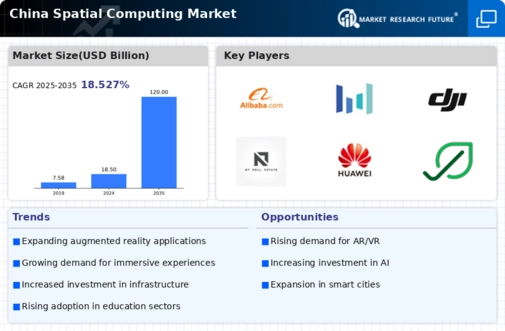The China Spatial Computing Market is being shaped by a rapidly evolving landscape characterized by technological advancements and increased investments from both domestic players and international entrants. As the demand for innovative spatial computing solutions rises, companies are accelerating their strategies to capture market share.
This competitive environment is defined by the emergence of various applications, including augmented reality, virtual reality, and mixed reality, across sectors, such as gaming, education, and industrial automation. Firms are leveraging their capabilities in artificial intelligence and machine learning to enhance user experience and deliver tailored solutions.
As a result, the competition is intensifying, with each player aiming to establish its unique position by focusing on R&D, strategic partnerships, and a robust market presence.Through the integration of comprehensive content ecosystems, cloud infrastructure, and hardware innovation, Tencent is becoming a prominent player in the spatial computing market in China. Its XR (extended reality) division is dedicated to the creation of cutting-edge AR/VR applications, with a particular emphasis on digital collaboration, social platforms, and gaming.
The company facilitates sophisticated virtual environments and interactive experiences by incorporating spatial computing into its core offerings, such as Tencent Cloud and WeChat. Tencent also promotes the development of the ecosystem by providing developers with open platforms and toolkits. Its presence is further fortified by strategic investments in spatial hardware firms and partnerships with headset manufacturers.
Tencent is developing a connected spatial computing framework that integrates digital and physical realities in both consumer and enterprise applications by capitalizing on its dominant positions in AI, entertainment, and social media.Alibaba has also made notable strides in the China Spatial Computing Market, leveraging its robust cloud computing capabilities and vast ecosystem.
The company offers key products and services, including cloud-based solutions for augmented and virtual reality applications, catering to various industries such as retail, education, and entertainment. Alibaba's strengths can be attributed to its extensive data resources and artificial intelligence advancements, which facilitate the development of rich spatial computing experiences. The firm has a strong market presence due to its wide-reaching platform and customer base across China.
Furthermore, Alibaba has engaged in strategic mergers and acquisitions to enhance its technological capabilities and broaden its service offerings in the spatial computing arena. These efforts have solidified Alibaba's position as a competitive player in the increasingly important field of spatial computing in China.













